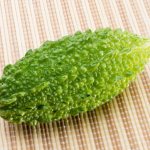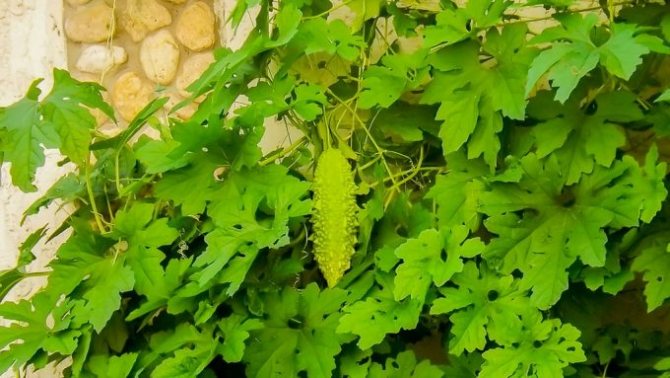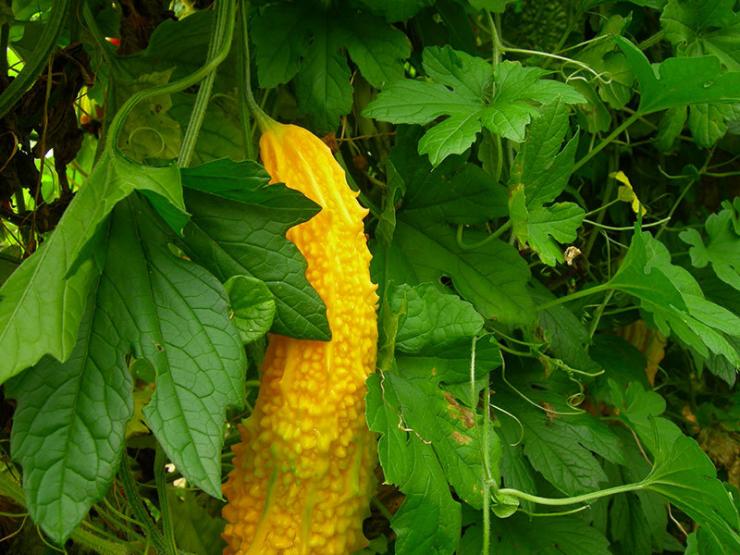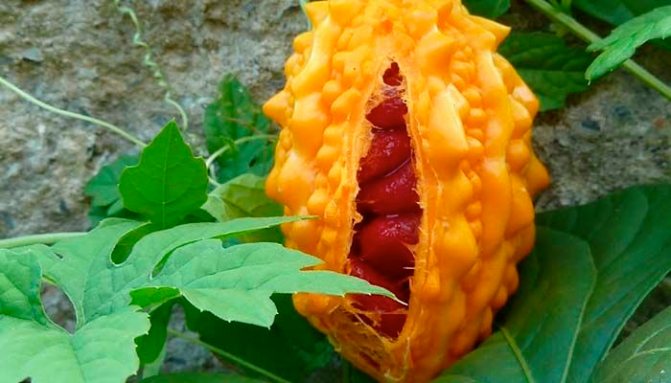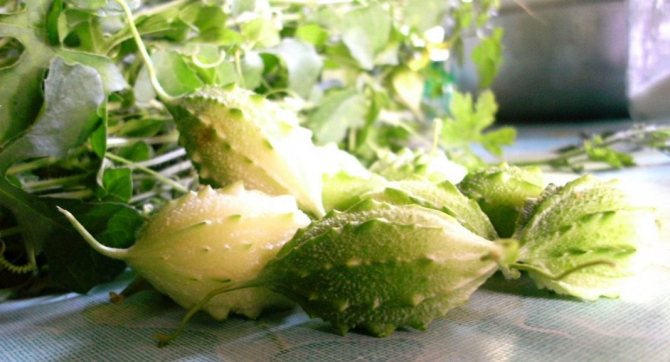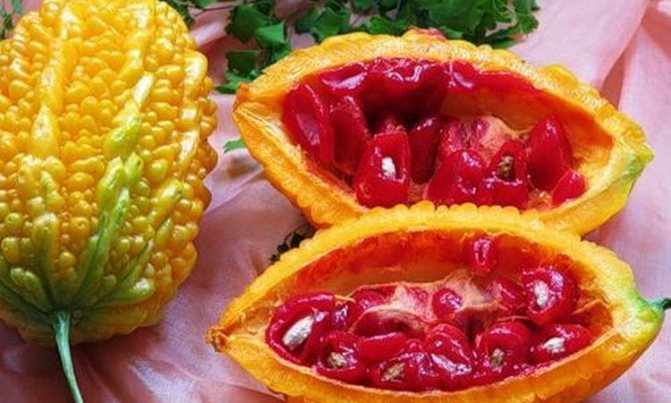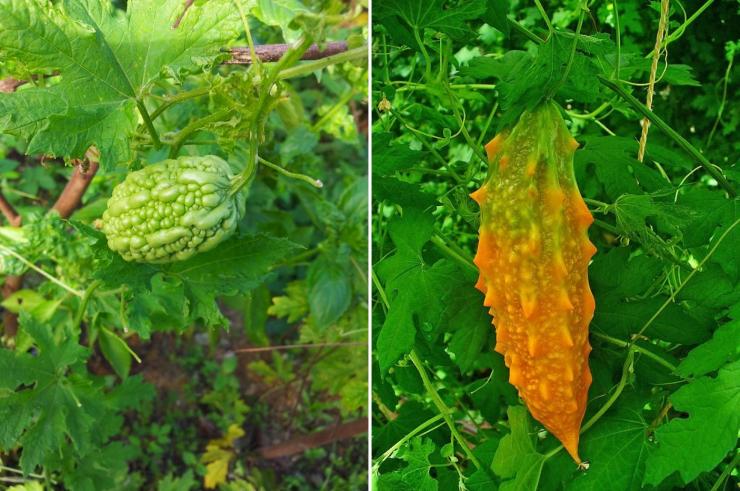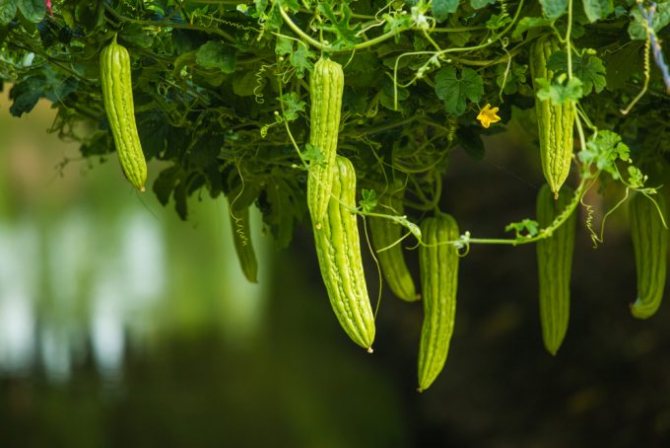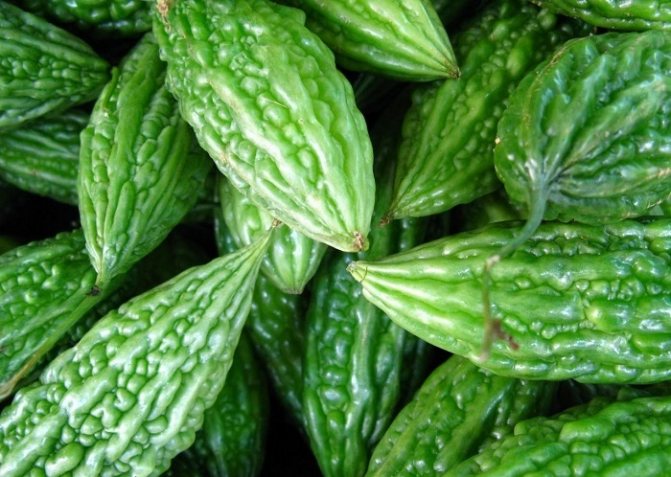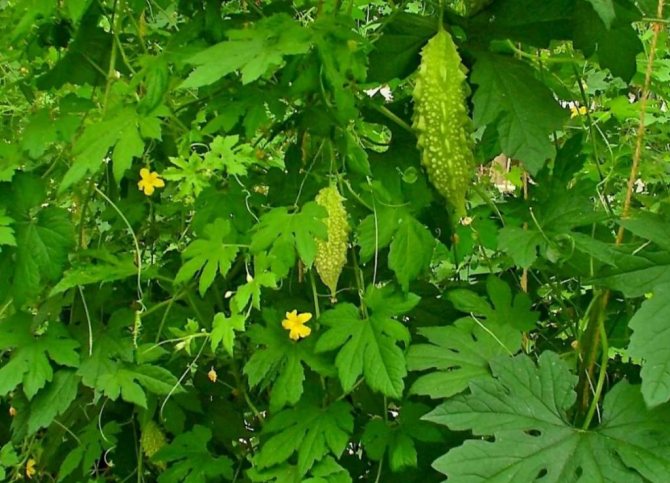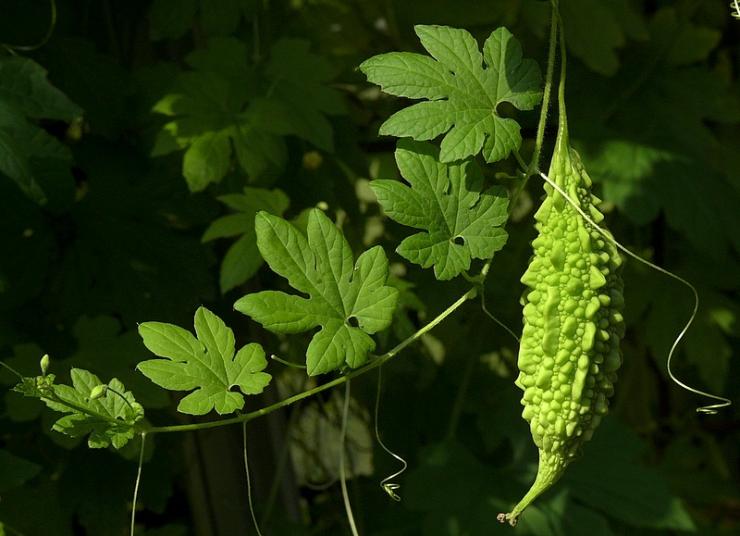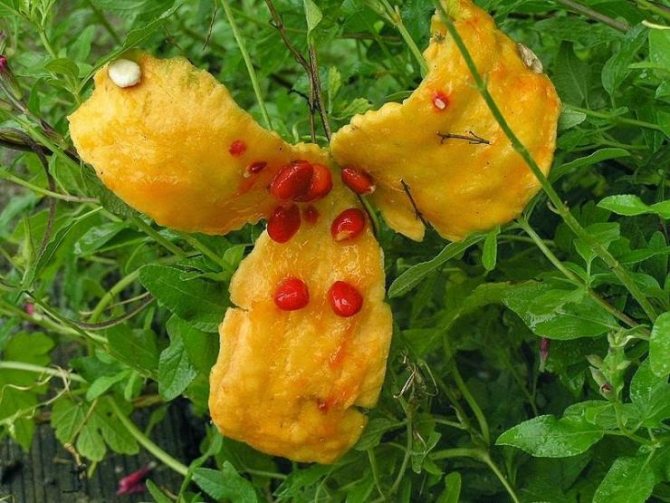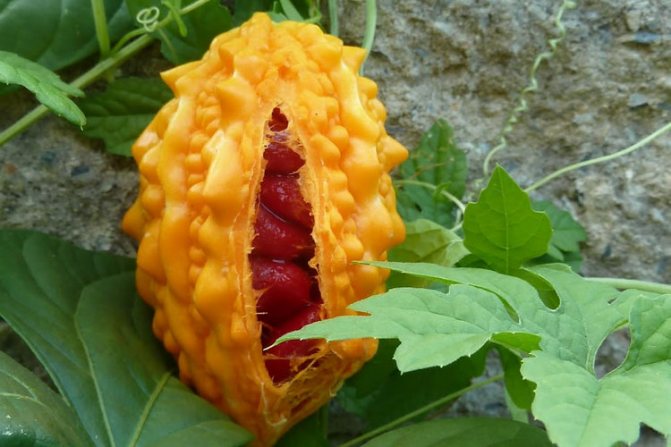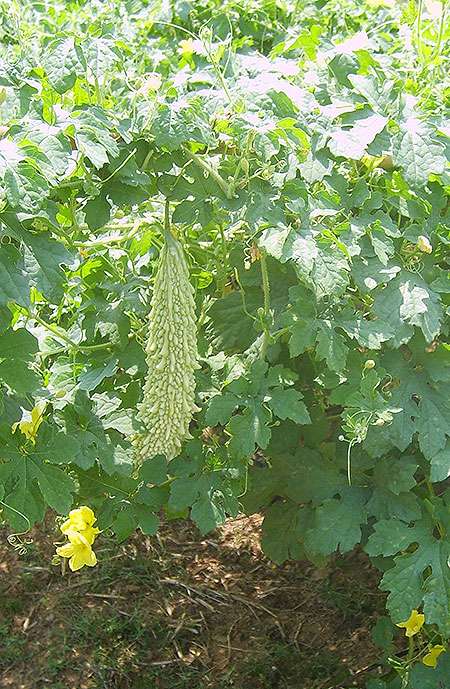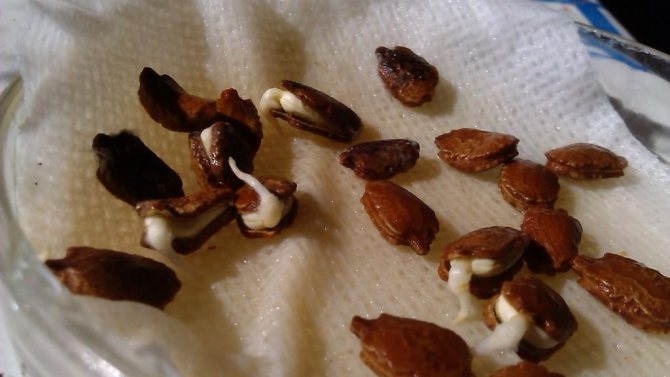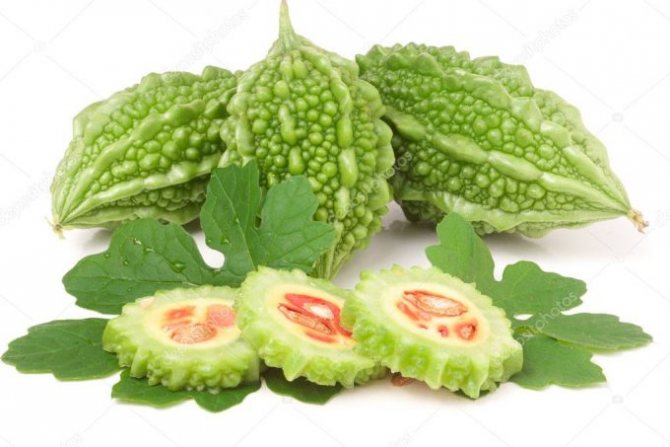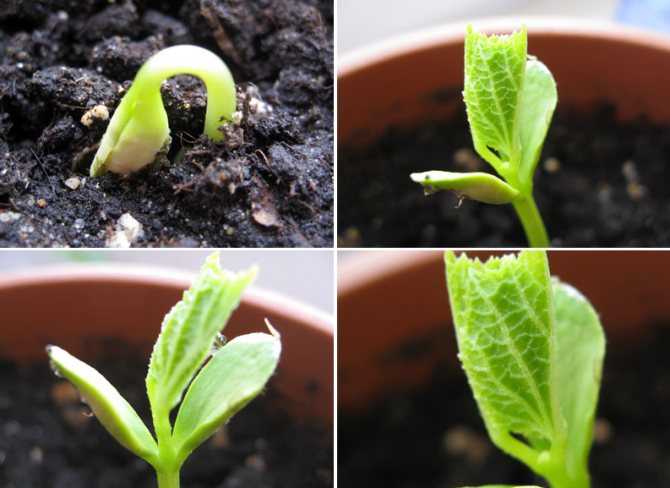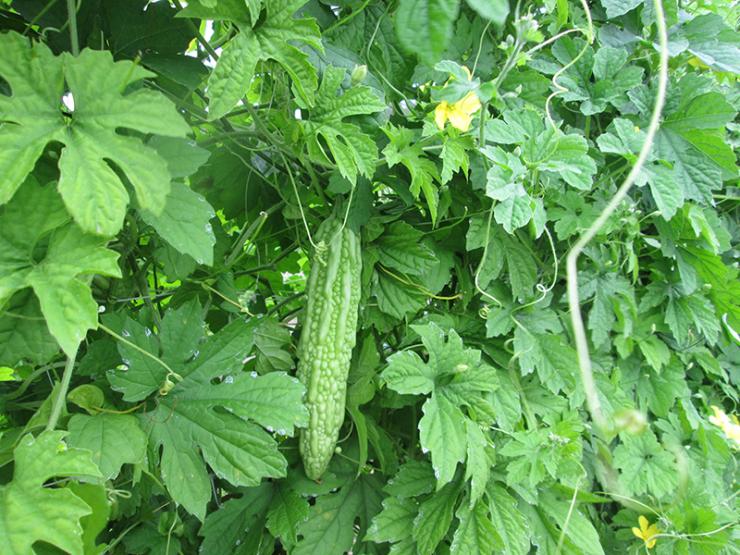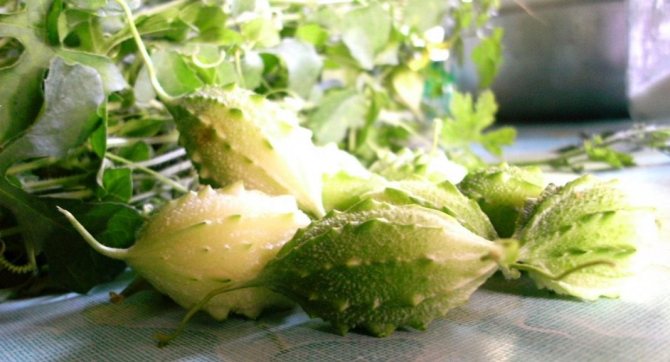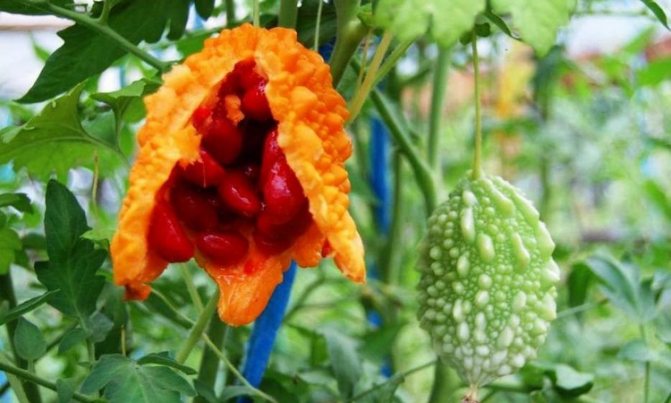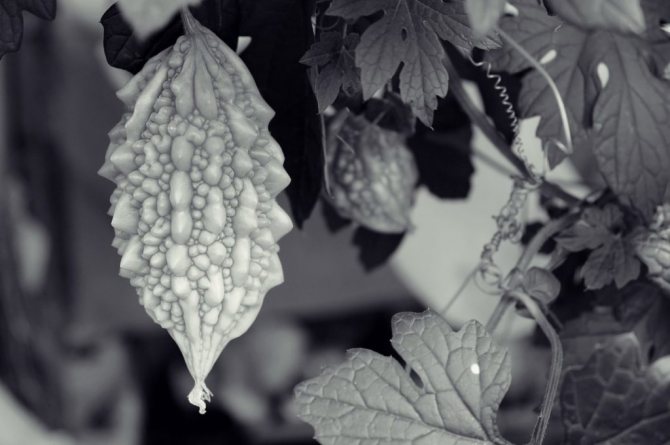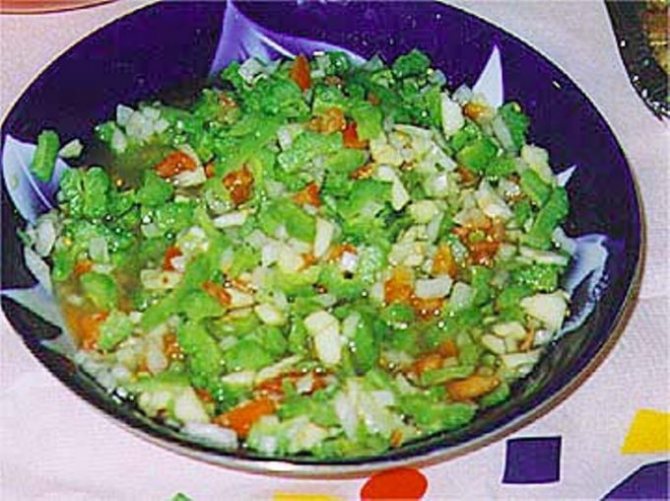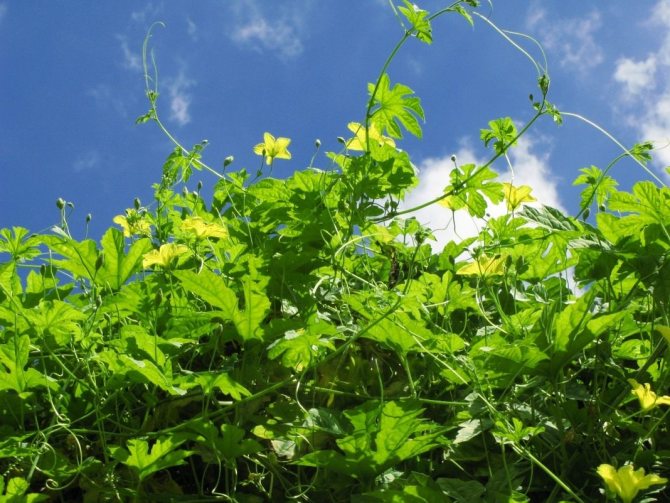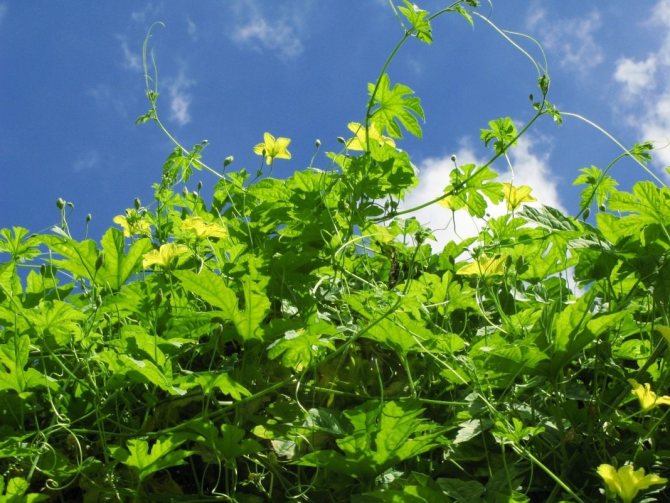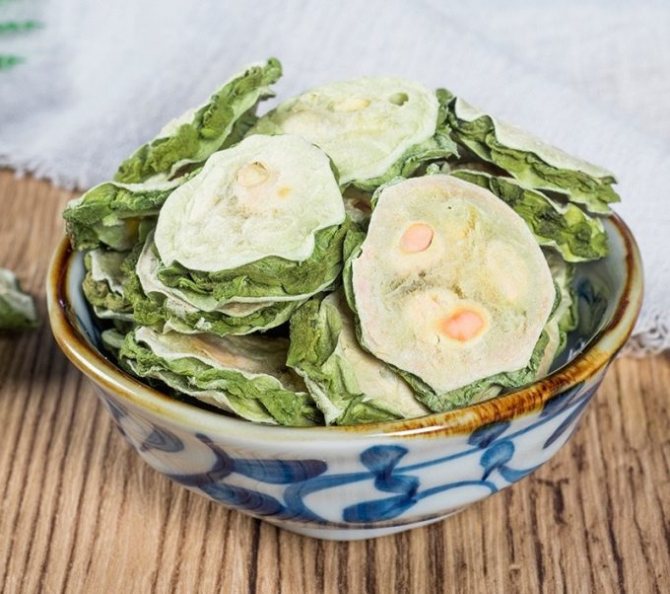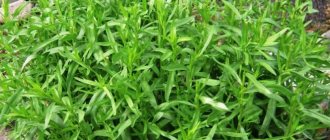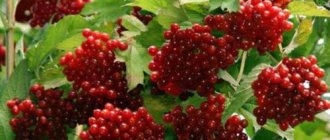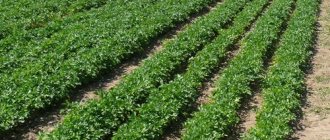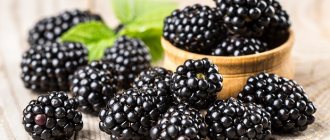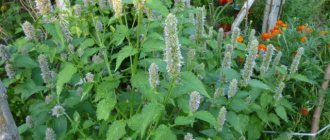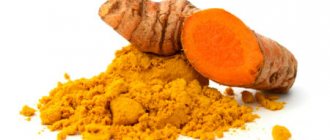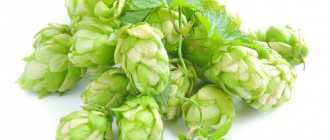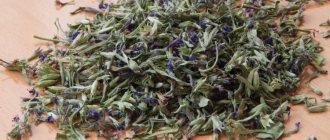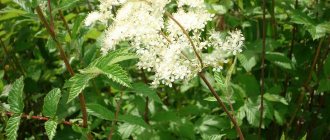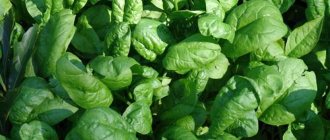Momordica is a herbaceous climbing vine from the pumpkin family. It has carved leaves, fragrant flowers and extraordinary fruits, ripe - similar to exotic bright orange flowers. She has many names: Indian, or yellow cucumber, crocodile cucumber, mad melon, Indian pomegranate, balsamic pear, etc. How to grow momordica in a greenhouse, on a balcony and in the open field, what kind of care it needs, and what properties are considered the most valuable, read the article.
The fruit of Momordica charantia, or bitter cucumber (Momordica charantia).
What is this plant "Momordica"
A plant from the Pumpkin family has a very unusual appearance and structure. Momordica bears elongated-oval fruits with a shriveled skin covered with thorns-growths, and with dark red pericarp seeds inside, covering brown seeds. When ripe, the fruits of the plant crack, and the juicy pulp is exposed.
The fruits are similar to both a fruit and a vegetable, they are considered close relatives not only to pumpkin, but also to squash and cucumber.
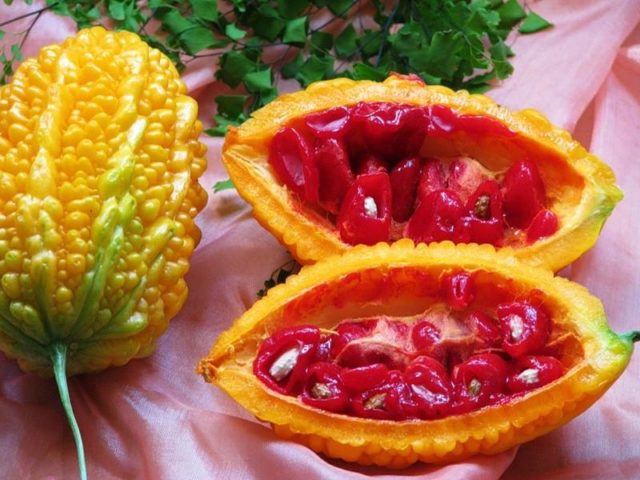
Momordica is a close relative of cucumbers and zucchini.
Where and how momordica grows
Exotic momordica, also called bitter melon or Indian pomegranate, grows mainly in the tropics. You can meet her in India, China, in Southeast Asia and South America, in the Philippines, in the Russian Crimea.
Fruits grow on large vines, reaching about 5 m in length. The leaves are carved, light green, slightly "biting" the fingers when touched, the flowers are bright yellow, with a jasmine scent.
Variety care
Momordica is not a capricious plant and therefore does not require special care. You should follow just a few simple rules that will not take you much time.
The most important thing is to avoid thickening your plant. It is usually recommended to leave three stems per piece. Everything else should be removed. If the plant has become taller than 50 centimeters, then you need to prune it. In order for momordica to grow well and branch, it needs to create a support. If it grows along the fence, then it does not need to rely on anything additional. Momordica is a very light-loving plant. Therefore, when planting, choose a place with good lighting. So that direct sunlight falls on your flower.
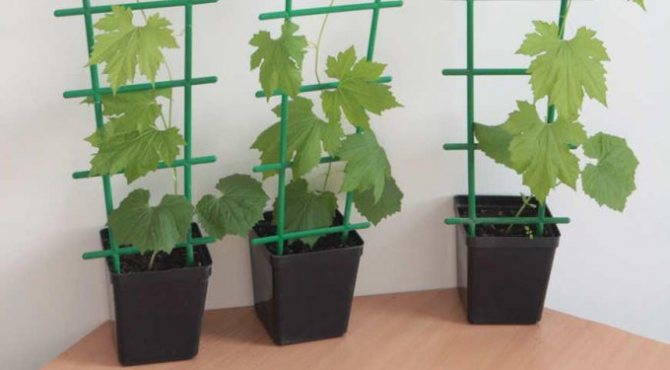

The fruits of the plant are best harvested on the 9th or 11th day from the moment they emerge. The more often you harvest, the more active momordica will bloom. However, do not forget that she can get tired and weaken from the constant harvest.
The value and composition of Momordica
The plant contains many valuable chemicals, which are responsible for the beneficial properties of momordica. In particular, the pulp contains:
- vitamins C, B and A;
- tocopherol;
- rare vitamin F;
- calcium and phosphorus;
- folic acid;
- the alkaloid momordicin;
- fixed oils;
- substance harantin;
- amino acids and saponins;
- glycosides, phenols and resins;
- alimentary fiber.
The value of the product is mainly represented by carbohydrates - about 3 g of the total. Fruits contain only about 0.8 g of protein, and about 0.1 g of fat.
Calorie content of momordica
The plant is highly regarded for its low calorie values.Only about 19 kcal is present in 100 g of the product, it is impossible to get better with the use of momordica.
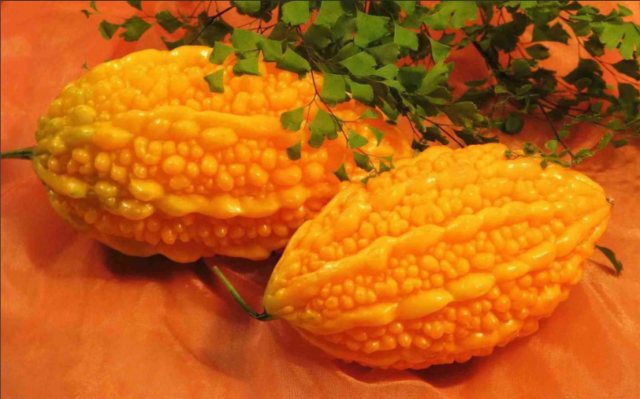

Fresh vegetables are eaten mostly unripe
How to care for young shoots?
You can transfer the plant to open ground or to an independent pot at the end of May. Choose a site carefully before the procedure. When planting momordica in the country, try to occupy the area where potatoes, tomatoes or cabbage grew last season. The optimal distance between the bushes (about 1 meter) will provide the fruit vine with a beautiful curl.
This exotic has a very thin root system. Care Tips:
- do not expose the roots;
- as the soil is washed off during watering, try to add new portions;
- do not loosen the soil under the bush, cut the weeds close to the ground.
Momordica is a thermophilic plant that dies from drafts. The place where the bush grows should be sunny, brightly lit. At home, a sill from the southeast side is best suited for this. The grown bushes can be transferred to a new container of 25-30 liters along with the peat pots.
At its core, Momordica is a vine. To provide her with the opportunity to curl beautifully, fasten her shoots to stable vertical trellises.
Momordica belongs to monoecious plants, that is, it has male and female flowers. Female flowers differ in that they appear later than male flowers and have a fruit-like base. Flowers and shoots begin to develop on the bushes at the same time. For a plant to bear fruit, it must be pollinated. In the natural environment, insects provide pollination. If your exotic grows on a windowsill, you will have to help him in this matter. To do this, pollen from male flowers is transferred to female flowers with a brush or cotton swab.
To achieve abundant fruiting, you need to cut off the lateral branches of the crown, achieving the formation of no more than 3 main stems. Also remove all branches covering the fruit.
To stimulate growth, fertilize the vine twice a month, alternating mineral and organic products.
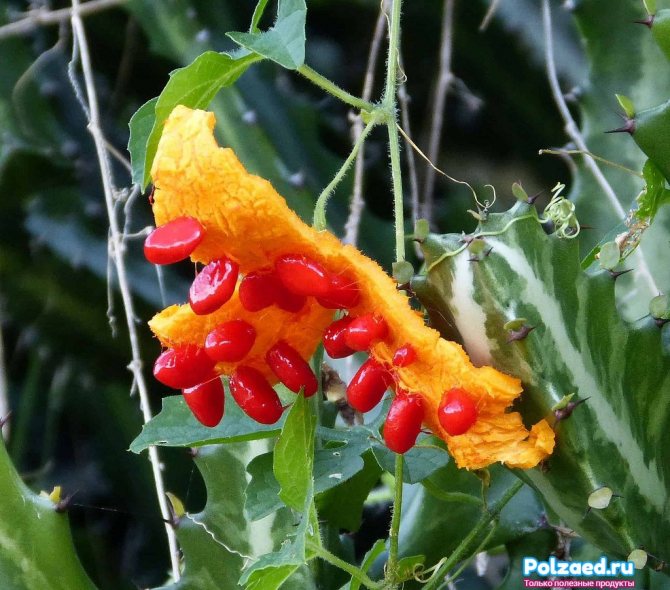

How to eat momordica
The pulp of the fruit is advised to be consumed unripe, in which case the taste will be more pleasant. Ripe momordica tastes distinctly bitter, so it is usually boiled before consumption and added to other dishes as a seasoning.
As for the seeds of the plant, they have a sweet taste, but are rather hard in structure. They need to be fried before use, this will soften the seeds and can be used in a salad or vegetable stew. The leaves of the plant are also often added to salads, put in soups and main dishes.
What does momordica taste like
Fresh unripe fruits taste like cucumbers. Ripe momordica is compared mainly to pumpkin, but more bitter. Some gourmets claim that the pulp is similar to both persimmon and melon at the same time.
Is Momordica a fruit or a vegetable?
You can stretch the ropes in the form of a fan, an arch or a solid wall. Young fruits are salted like cucumbers, fried in thin slices, like potatoes, and ripe fruits are canned and pickled. Momordica tastes better. It is added to cucumbers, which not only decorates cans with blanks, but also makes them tastier.
Momordica grows well outdoors. You need to grow it through seedlings. Caring for her is normal, like for cucumbers. Before sowing, the seeds are treated in a saturated solution of potassium permanganate, then soaked in warm water for a day, then rinsed, wrapped in a clean damp cloth, placed in a plastic bag and kept warm at 30-40 ° C. After pecking, the seeds are placed one at a time in half-liter cups in the nutrient soil, always on the edge, then they are covered with polyethylene or glass.
Seedlings are planted in fertile soil.On a balcony or loggia, it is poured into large plastic bags installed in boxes, buckets or other containers. Plants need to be watered regularly throughout the summer. It is better to remove excess vines so that they do not shade each other, since with a lack of light, the number of fruits decreases.
Video on how to germinate momordica seeds:
| |
| Momordica charantia in the garden in Gokarna | |
The Ayurvedic name for Momordika is Karela. Other names for momordiki: bitter cucumber, Chinese cucumber or Chinese bitter gourd, Indian pomegranate.
Momordica or "bitter gourd" contains a high concentration of vitamins, minerals and antioxidant compounds. It has many health benefits and is widely used to lower blood sugar and bad cholesterol. In addition, certain components of the plant are considered as potentially promising materials for the development of new anticancer drugs.
Useful properties of the momordica plant
The pulp and seeds of the plant not only have an unusual pleasant taste. The product is good for health, it can bring relief from many diseases. The plant has anti-inflammatory properties, has a good effect on blood circulation and metabolism, strengthens the immune system.
The product is used to treat:
- colds and viral diseases;
- measles;
- hepatitis A;
- scabies and psoriasis;
- parasites;
- liver and kidney diseases.
The plant helps to lower cholesterol levels, improves blood composition and accelerates blood circulation, and serves as a quality prevention of strokes and heart attacks.
Important! The substance harantin in the composition of the plant has a beneficial effect on the pancreas and promotes the production of insulin. The plant is of particular benefit in diabetes mellitus.
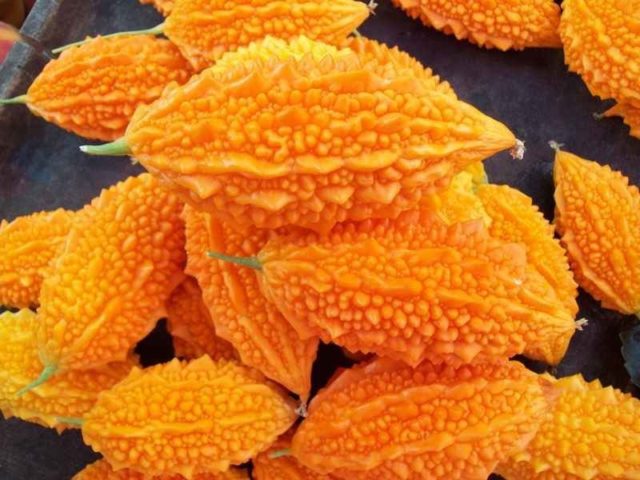

Indian pomegranate can be used to treat diseases
Healing properties of Momordica leaves
The leaves of the plant contain many vitamins and antioxidants. Broths and infusions based on Momordica foliage are used to treat metabolic system failures, to strengthen the heart and blood vessels, and to increase immunity.
Useful leaf-based products help with skin inflammation and joint ailments. You can drink decoctions in the treatment of hypertension and weight loss, for the prevention of oncology and rejuvenation of the body.
The chemical composition of the fetus
This tropical plant, which has stepped into our latitudes, is not for nothing considered such a useful and unique fruit. After all, Momordica stores a truly treasure trove of the substances we need. Moreover, not only its fruits are appreciated, but also all other parts of the plant: root, stem, leaves. What is Momordica so rich in? The beneficial properties of the plant are explained by its composition.
- The red shell of the fruit, which encloses the seed, contains a carotene-rich oil. Everyone knows that this substance in our body turns into vitamin A, the benefits of which hardly anyone would argue.
- The seeds of the plant are also rich in lycopene. It is the most powerful antioxidant that exists today. Moreover, it can enter our body only with food.
- Laboratory studies have proven the presence of triterpene saponins in Momordica root. And these substances are simply irreplaceable in the treatment of rheumatism.
- And, of course, one cannot but mention phytoncides, which kill numerous viruses and bacteria.
- And take a harantine that lowers blood sugar? It turns out that the fruit is a natural medicine, the use of which is very useful for those who suffer from type 2 diabetes.
The composition of the red shell of the seed contains essential oil, which contains healing carotene (32%). In the human body, the orange plant pigment is converted into vitamin A, which improves visual acuity.Bitter melon seeds are rich in lycopene, which has a high antioxidant effect and prevents the appearance of heart and vascular diseases.
Why Momordica is beneficial for health
The plant is used in both folk and official medicine. When consumed, it brings the following beneficial effects to the body:
- cleans blood vessels and strengthens their walls, preventing heart attacks and strokes;
- improves metabolic processes, helps with digestive disorders and liver diseases;
- has a diuretic effect and helps with kidney ailments;
- effectively fights inflammatory processes in the body and skin diseases;
- helps with colds, as well as asthma;
- has a beneficial effect on arthritis;
- improves the condition of the reproductive system;
- lowers glucose levels and improves the functioning of the pancreas.
The plant is used to enhance immunity and to prevent vitamin deficiency. The use of Momordica can prevent the development of malignant tumors.
The healing properties of Momordica
Traditional medicine especially appreciates the plant for its beneficial effects in diabetes and a tendency to oncology. Although the product must be combined with medications, Momordic has a very good adjuvant effect.
Momordica for diabetes
The product contains the substance harantin, this component improves the production of insulin by the pancreas. In diabetes mellitus, it is very helpful to include momordica in the regular menu. The product will prevent sudden fluctuations in glucose levels. In diabetes mellitus, complications such as pancreatitis and obesity are dangerous, but momordica helps prevent their development.
Momordica in oncology
Official research confirms that momordica can help treat cancer. Triterpenes, steroids, minerals and vitamins in the composition of the plant inhibit the growth of malignant neoplasms and slow down the development of negative processes. The product cleanses the body of toxins, reduces the size of tumors and is beneficial for oncology of the stomach, prostate, liver, breast, and leukemia.
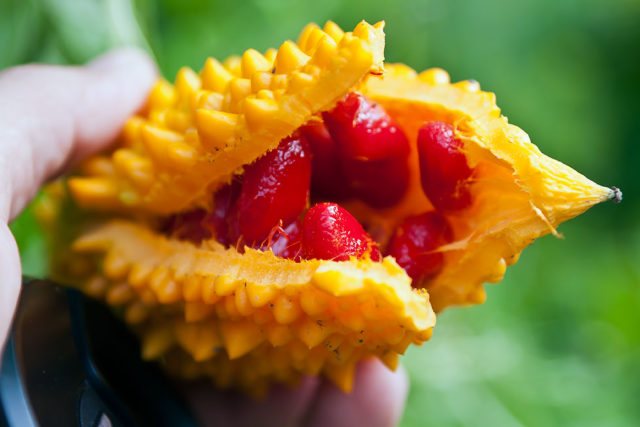

Useful fruits serve as the prevention of oncological ailments
Attention! For all its benefits, the plant cannot serve as the only cure for oncology. It is possible to use momordica for cancer only in combination with traditional therapy.
Soil features
Photo of soil for growing Momordica
- Momordica is quite demanding on soil fertility. Experienced gardeners recommend planting it in the place where tomatoes, peas, beans, pumpkin or potatoes were previously grown. Caring for her is no more difficult than caring for a pumpkin or cucumber.
... It is important to create the necessary conditions for development and growth.
- It is recommended to feed with organic fertilizers, which are poured in the open field under digging (up to 8 - 10 kg per 1 m2). It is recommended to alternate organic fertilizer with mineral fertilizer.
- Momordica does not like excessive acidity of the soil. If the soil of the garden is acidic, it is recommended to supply it with lime per 1 m2 of the garden area.
- There should be no stagnant water
... This can lead to the beginning of rotting of the root system, which will result in death. This plant loves sunlight and does not tolerate darkened areas.
How to use momordica for treatment
Traditional medicine and dietetics offer specific healing recipes based on Momordica. When using them, the beneficial effect of using the product will come faster.
How to use momordica for diabetes
Diabetes benefits from the use of pulp and the use of momordica seeds as a condiment. But it is also recommended to prepare a special tea based on the leaves. They do it like this:
- finely chop green leaves in the volume of half a large spoon;
- pour a glass of hot water;
- close with a lid and wait until the product cools down to a warm temperature.
You need to drink this tea up to 2 times a day instead of regular tea. It is undesirable to add lemon or sugar to the drink.
Transplant technology
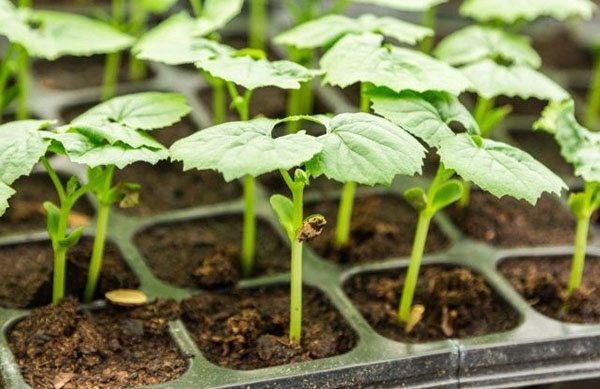

The optimal time when Momordica can be planted in open ground is 45 days after sowing. To prevent the plant from dying on cold nights, the air temperature should not be lower than + 15 ° C. Experienced gardeners recommend waiting for the apple trees to bloom, or planting the crop in a greenhouse.
Low air temperature can lead to growth arrest and death of the thermophilic momordica.
- Dig holes 35 cm deep, with a step of 55 cm between them;
- Place the plant in the hole by transshipment, without disturbing the earthen lump, or together with the peat container;
- Cover with soil on top and pour at the rate of 3 liters of water under one root.
All actions must be performed with extreme caution, trying not to damage the fragile roots.
Requirements for soil composition and location
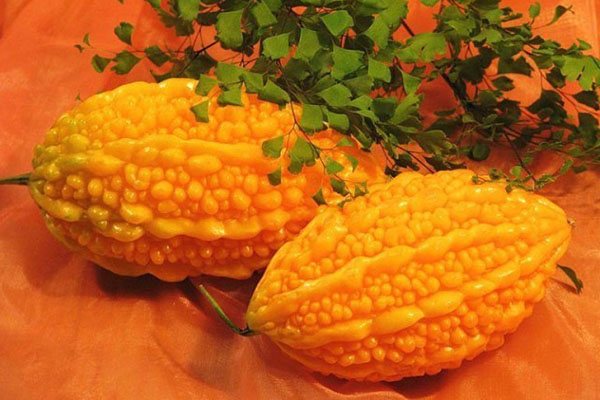

Planting in the open ground of Momordica requires certain conditions, since the thin root system does not tolerate transplanting well. Clay soil with an admixture of sand and humus with a low or neutral level of acidity is considered optimal. In the presence of acidic soil, it is necessary to mix it with lime in the fall at the rate of 200 g per 1 m 2.
Before planting seedlings, the soil must be loosened and watered with organic fertilizers. In the future, seedlings should be fed twice a month, alternating potash and phosphorus fertilizers.
To grow Momordica Indian cucumber, choose an area that is protected from drafts and direct sunlight, but at the same time with sufficient light. The crop is doing well in areas where tomatoes, legumes, pumpkin or potatoes were grown.
Application of Momordica
Indian pomegranate is widely used in home treatment, in personal care and in dietetics. There are many recipes based on seeds, pulp and leaves to get the most out of the product.
Momordica in folk treatment
For the treatment of ailments, all parts of Momordica are used - fresh pulp, seeds and green leaves. On their basis, decoctions, infusions and strong tinctures are prepared. If you follow the recipes, the beneficial effect will appear quickly.
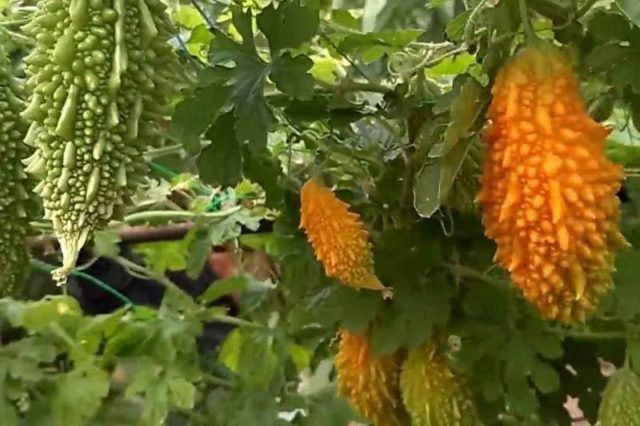

In home medicine, the leaves and seeds of the plant are used along with the fruits.
Infusion on the leaves for skin diseases
For scabies and measles, you can prepare the following remedy:
- chop 1 large spoonful of fresh leaves;
- pour a glass of hot water;
- darken in a water bath for 45 minutes;
- strain and top up with clean water to the initial volume.
The resulting infusion is used to wipe the irritated skin and make compresses. Useful components in the composition help to quickly cope with inflammation.
Seed decoction for fever
With inflammatory processes and temperature, the following remedy is beneficial:
- 20 g of plant seeds are poured with 200 ml of hot water;
- boil for 10 minutes;
- insist after readiness for 1 hour, then filtered.
You need to drink the broth three times a day, 50 ml, in total, the therapy continues for a week. The remedy has a good diuretic effect.
Immunity Strengthening Blend
With a weakened immune system, Indian pomegranate in combination with honey and nuts is beneficial. Prepare the medicine like this:
- the fruits are crushed in a meat grinder or blender to a state of gruel;
- the pulp is mixed with 250 g of finely chopped walnuts;
- add 300 ml of liquid honey.
Disease and pest control
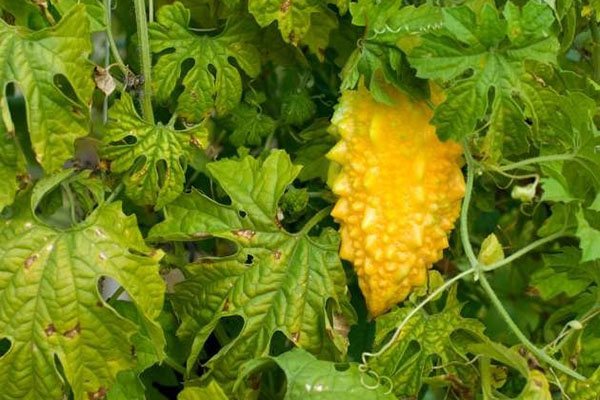

Momordica is similar to cucumbers, not only in appearance. Crops are susceptible to similar diseases and pests, each of which requires treatment:
- bacteriosis (Bordeaux mixture);
- aphids (special chemical compounds);
- powdery mildew (fungicides);
- white rot.
The plant can turn yellow as a result of temperature changes. In such a situation, it can be processed with onion infusion or ash.When the root system decays, fresh fertile soil must be poured around the bush. To avoid diseases and pest attacks, you need to carefully consider the frequency of watering, since the plant weakens mainly due to damage to the root system.
Having figured out when to sow momordica and how to properly care for it, you can safely start planting an exotic culture in a garden plot or even a balcony.
All about growing momordica - video
You are worried about the question growing momordica from seed? Probably also at home? After reading this article, you will learn how to do it step by step!
What kind of plant is this? Let's meet in this video!
Momordica Is a southern climbing plant that belongs to the pumpkin family. People often call it Indian or yellow cucumber. It is grown in apartments or in a suburban area.
Momordica is a wonderful decorative decoration for windows, gazebos, balconies. Due to the fact that its fruits have medicinal properties, it is used not only in cooking, but also for medicinal purposes.
Limitations and contraindications
In some diseases, the beneficial properties of Momordica can be detrimental. You need to refuse to use it:
- in the presence of individual intolerance;
- during pregnancy and breastfeeding;
- during the period of acute pancreatitis;
- with diseases of the adrenal glands;
- with hypothyroidism and thyrotoxicosis.
It is necessary to take funds based on Momordica with caution in case of gastric ulcer, colitis and gastritis. It is better to use the plant during the period of remission, and during exacerbations it is worth removing it from the diet.
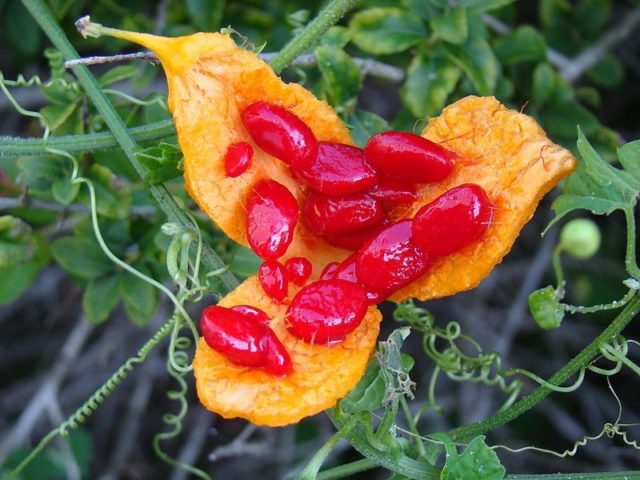

The product has few contraindications
How to care for seedlings?
A mixture for transplanting sprouted material into the ground can be purchased at the store, or you can prepare it yourself. To do this, you will need:
- the soil;
- sand;
- rotted foliage.
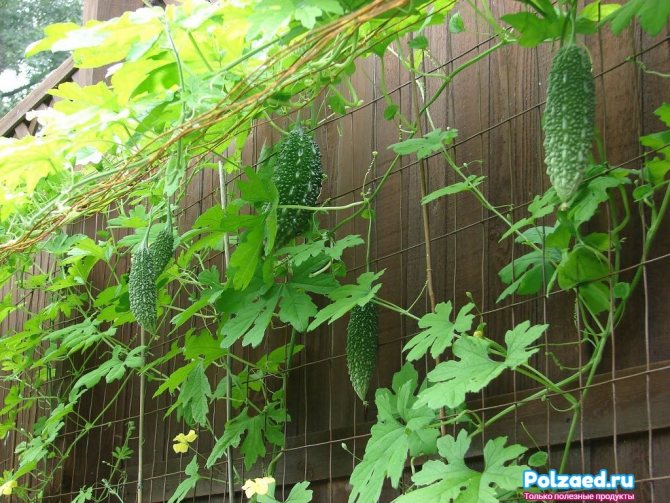

Mix all the ingredients in a 1: 1: 0.5 ratio and fill the peat cups with this mixture. The seeds must be transferred to the ground 1.5 cm deep, moistened abundantly, covered with foil or plastic, and placed in a warm place. It will be possible to water the plant next time only after 2 days. During the entire period of seedling germination, control the moisture content of the soil mixture. It shouldn't dry out.
After the sprouts appear, you can remove the protective film and spray the seedlings with water from a spray bottle. Containers with seedlings should be placed on a windowsill with sufficient lighting, away from drafts. It is recommended to protect the future liana from the action of the scorching sun with thin paper or a curtain. On warm days, you can practice hardening your crop by exposing the shoot pots to fresh air.
Momordica can also be propagated by cuttings. To do this, you must place the shoots in water or a mixture containing peat and place them in a warm place. When the cuttings take root, they should be transferred to open ground and covered with a glass jar. This method is suitable if you decide to plant a plant in the country.
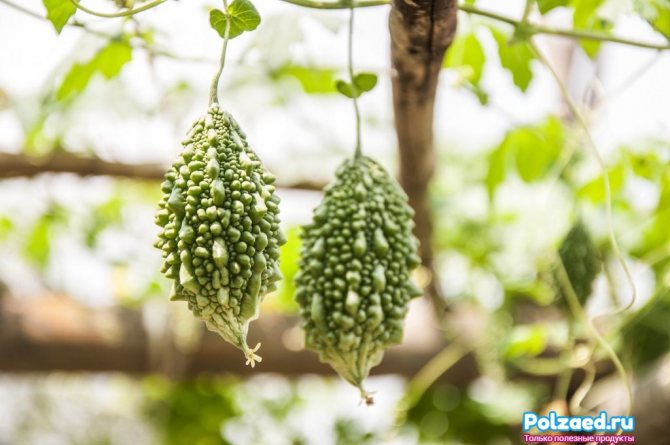

Selection and storage rules
It is best to buy momordica in a store in the fall - in September or October, during the period of natural maturation.
It is best to choose light yellow or green unripe fruits, they have better taste. Orange or pink momordica has the same benefits, but tastes bitter and needs to be processed before use. Fruits should be evenly colored, without dark spots and suspicious dots.
They are stored in a refrigerator at high humidity, their beneficial properties are preserved for 2-3 weeks. As for the leaves and seeds, they can be dried for medicinal use and stored in a dark dry place for 2 years.
Momordica - growing from seeds: preparing for germination, planting
Liana is thermophilic, with our short summer, the seedling method of growing is preferable. It is better to do this in the last days of March or a little later.First, the seeds are examined. They are covered with an interesting elaborate pattern. Fully ripe - black or dark brown, choose them. Light ones may indicate immaturity, such are unlikely to rise. The seed should be large, at least one and a half centimeters in length, with a very dense shell.
Do you know what “seed scarification” is? This is the mechanical destruction of the seed skin, which is produced for faster germination. Use sandpaper or a diamond nail file for the process. The seed is rubbed with the device, the shell becomes thinner.
After that, the seeds are dipped into a growth stimulator or a pink solution of potassium permanganate, soaked for several hours, wrapped in a damp cloth and left in a warm place for 7 to 14 days, periodically moistening the fabric and checking if there are already elastic white roots. You can germinate seeds in wet sawdust. It is important not to let them become waterlogged and rot.
Each sprouted seed is planted in an individual container, preferably a peat pot, so that when the seedlings are moved into the soil, they do not harm the weak roots.
The technology is simple:
- Earth is poured into pots, compacted.
- The seed is stuck in an edge, sprinkled with soil mixture or sand.
- Each seed is generously moisturized.
- The pots are moved into a spacious container, the crops are covered with foil or glass.
The temperature for successful germination of mad cucumber seeds is above + 20 ° С. We will see the first shoots in about two weeks.
The shelter is removed, the sprouts are sprayed, the pots are transferred to a windowsill, illuminated by the sun (the southeast side is ideal). So that the spring rays do not harm the delicate stems, the window is shaded on hot days.
Is it possible to grow momordica at home
If you wish, you can grow Indian pomegranate at home - Momordica propagates by seeds and cuttings. Preference is usually given to seed propagation, the seeds are planted in peat pots and watered regularly.
Ascended momordica can be transplanted into the ground on the site, or you can leave it indoors. In addition to watering and feeding with complex minerals, the plant needs pruning. From spring to autumn, excess lateral processes are removed from the momordica and the central stem is pinched. Since the plant is a long liana, a support must be set up for Momordica when growing.
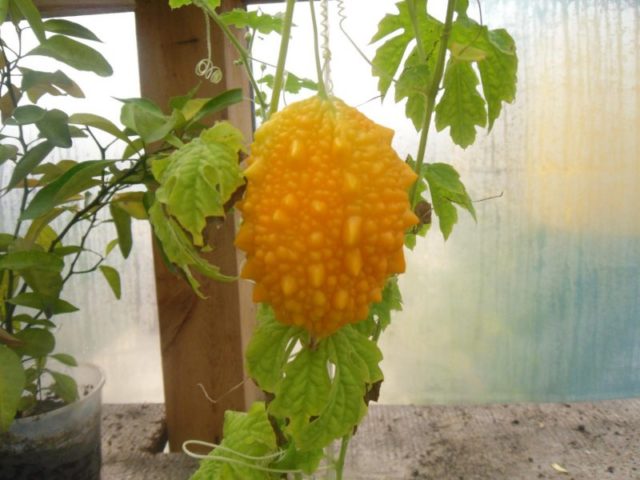

You can grow Indian pomegranate at home, it reproduces well by seeds.
Landing on the site
Planting is recommended late May or early June
... You can do this a little earlier. The main thing is that warm spring weather has already settled on the street in the daytime and at night.
In our lane, it is recommended to grow momordica in a closed greenhouse or greenhouse. Some gardeners are planted in open ground and covered with thick film at night and in the rain. The southern regions have a milder and warmer climate and hot summers.
There is no need to install a greenhouse. The root system of Momordica is weak. Roots can be damaged during planting, so care must be taken.
For planting, holes are prepared in advance at a distance of 50 - 60 cm from each other (not less). The soil should be saturated with humus and moistened before planting.

